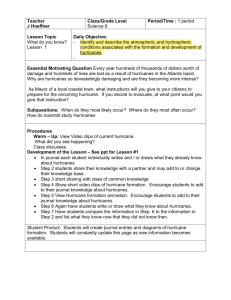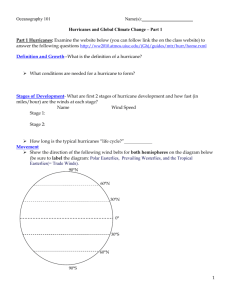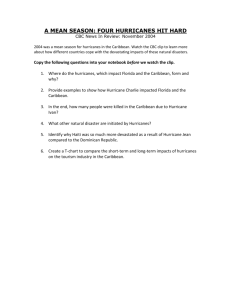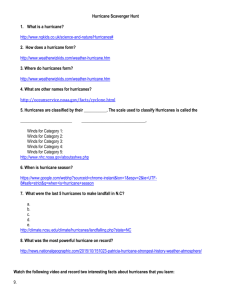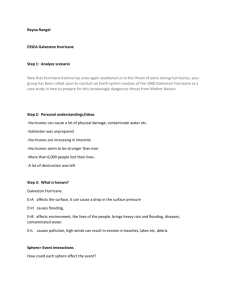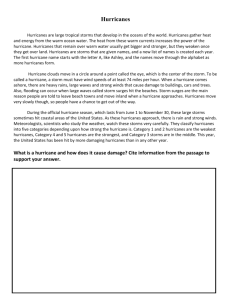Microsoft Word
advertisement
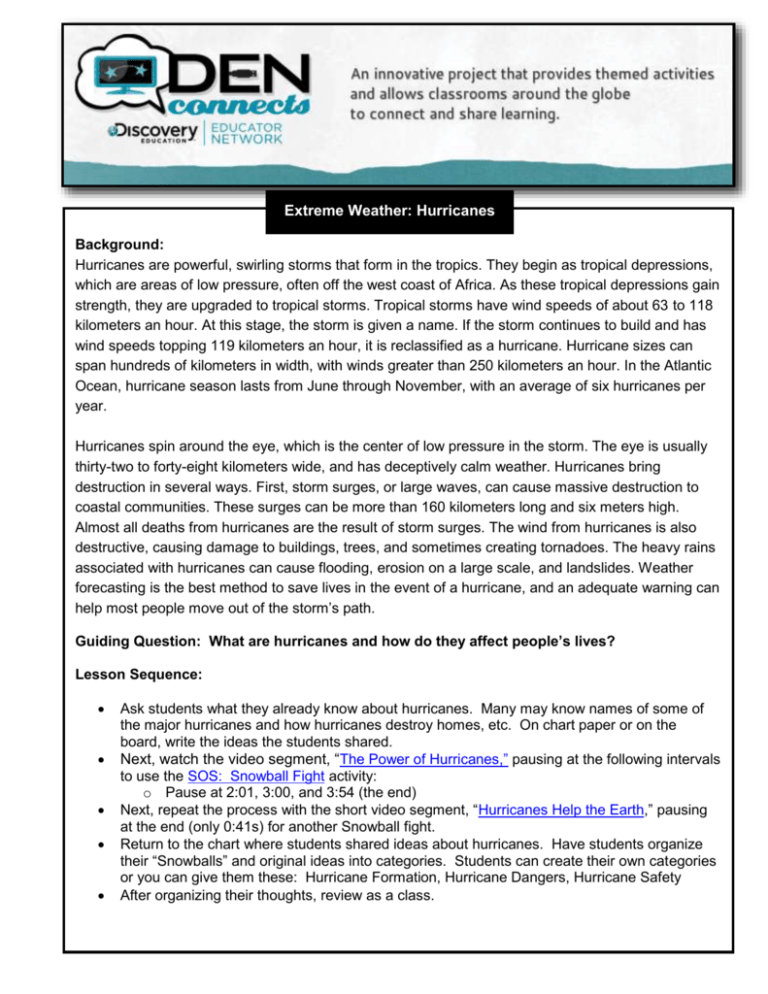
Extreme Weather: Hurricanes Background: Hurricanes are powerful, swirling storms that form in the tropics. They begin as tropical depressions, which are areas of low pressure, often off the west coast of Africa. As these tropical depressions gain strength, they are upgraded to tropical storms. Tropical storms have wind speeds of about 63 to 118 kilometers an hour. At this stage, the storm is given a name. If the storm continues to build and has wind speeds topping 119 kilometers an hour, it is reclassified as a hurricane. Hurricane sizes can span hundreds of kilometers in width, with winds greater than 250 kilometers an hour. In the Atlantic Ocean, hurricane season lasts from June through November, with an average of six hurricanes per year. Hurricanes spin around the eye, which is the center of low pressure in the storm. The eye is usually thirty-two to forty-eight kilometers wide, and has deceptively calm weather. Hurricanes bring destruction in several ways. First, storm surges, or large waves, can cause massive destruction to coastal communities. These surges can be more than 160 kilometers long and six meters high. Almost all deaths from hurricanes are the result of storm surges. The wind from hurricanes is also destructive, causing damage to buildings, trees, and sometimes creating tornadoes. The heavy rains associated with hurricanes can cause flooding, erosion on a large scale, and landslides. Weather forecasting is the best method to save lives in the event of a hurricane, and an adequate warning can help most people move out of the storm’s path. Guiding Question: What are hurricanes and how do they affect people’s lives? Lesson Sequence: Ask students what they already know about hurricanes. Many may know names of some of the major hurricanes and how hurricanes destroy homes, etc. On chart paper or on the board, write the ideas the students shared. Next, watch the video segment, “The Power of Hurricanes,” pausing at the following intervals to use the SOS: Snowball Fight activity: o Pause at 2:01, 3:00, and 3:54 (the end) Next, repeat the process with the short video segment, “Hurricanes Help the Earth,” pausing at the end (only 0:41s) for another Snowball fight. Return to the chart where students shared ideas about hurricanes. Have students organize their “Snowballs” and original ideas into categories. Students can create their own categories or you can give them these: Hurricane Formation, Hurricane Dangers, Hurricane Safety After organizing their thoughts, review as a class. Extreme Weather: Hurricanes Activities: 1. Explore hurricanes with hands on experiments. Hands on Activity: Model a Hurricane and Hands on Activity: Make a Hurricane are two Discovery Education resources for this activity. 2. Connect with classrooms! Use these extreme weather lessons to connect with classes who have experienced different types of extreme weather. For example, try to connect with a class this week in Florida, Texas, or North Carolina who may have experienced hurricanes. 3. Create a board in Board Builder featuring hurricanes and how they affect people throughout the world. Want More? National Hurricane Center This site, specifically under the Outreach and Education section on the left, has information about hurricane forecasting, naming, etc. Connect with Weather Virtual Field Trip video with meteorologist, Mark Elliot This is an archived Discovery Education Virtual Field Trip with the Weather Channel. Along with the virtual field trip, the link includes video segments related to several types of extreme weather. Check it out! Discovery Kids: Extreme Weather The link above to Discovery Kids has several video segment resources for Extreme Weather, as well as games and other activities for students. National Geographic Extreme Weather This link has wonderful images of extreme weather to share with students, along with some articles.


